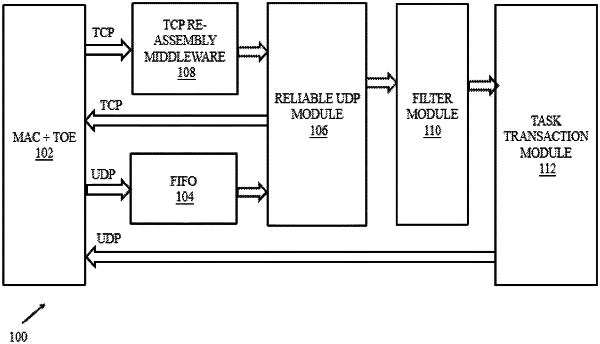| CPC H04L 69/16 (2013.01) | 12 Claims |

|
1. A Field Programmable Gate Array (FPGA) implemented method for a low-latency FPGA frame-work based on reliable User Datagram Protocol (UDP) and Transmission Control Protocol (TCP) re-assembly middleware:
receiving a plurality of data packets as input from a plurality clients, wherein the plurality of data packets are associated with a digitally configured task to be performed for the client by the FPGA and the plurality of data packets enables one of a TCP and a UDP, wherein each data packet within the plurality of data packets comprises a channel sequence number indicative of the client;
assembling the plurality of data packets based on the channel sequence number; identifying a missing channel sequence number in the assembled data packets based on a pre-defined sequence;
performing, based on the identification of the missing channel sequence number in the assembled data packets:
on identifying presence of the missing channel sequence number in the assembled data packets, requesting a re-transmission of the assembled data packets with the missing channel sequence number over a TCP channel based on a reliable UDP logic from the client to obtain a complete assembled data packets based on a TCP re-assembly logic, wherein the TCP re-assembly logic comprises converting the data packets into the complete assembled data packets at a pre-defined frequency based on a memory optimization implemented for a memory in a TCP First-In-First-Out (FIFO), wherein the memory includes a message writer memory, a data segment memory, and a descriptor memory,
wherein memory optimization implemented to the memory in a TCP re-assembly middleware architecture includes:
i. registering an output for a memory, wherein registering is implemented by utilizing a register and an input controller placed at the output of the memory, wherein registering the output for the memory enables implementation at the pre-defined frequency by:
a. holding a data for one clock to synchronize the data for one clock cycle;
b. the process of registering the output of memory for two clock, the FPGA is synthesized or implemented at the pre-defined frequency;
ii. slicing the memory based on a pre-defined slicing threshold to enable a FPGA implementation at the pre-defined frequency, wherein the slicing includes a horizontal slicing and a vertical slicing; and
on identifying absence of the missing channel sequence number in the assembled data packets, the assembled data packets to be retained as the complete assembled data packets;
extracting a plurality of relevant features from the complete assembled data packets using a domain knowledge base;
performing the digitally configured task using the plurality of relevant features from the complete assembled data packets; and
sharing the performed digitally configured task as an output to the client in response for the received data packets.
|